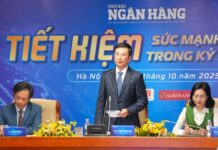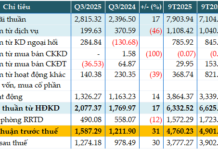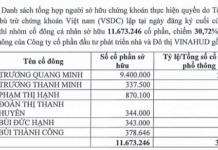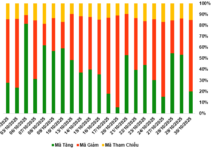It’s not just a simple transaction
At the seminar on the topic “Carbon Financial Market: Opportunities and Challenges for Vietnam’s Wood Industry” organized by HAWA Vietnam on March 7, 2024 in Ho Chi Minh City, Assoc. Prof. Dr. Nguyen Dinh Tho – Director of the Institute of Strategy, Resource and Environmental Policy, Ministry of Natural Resources and Environment, said that according to WB statistics, by the end of 2022, the global carbon market had a scale of about 92 billion USD and was growing rapidly.
In Vietnam, the current market size is about 2 billion USD and most of the carbon credits are sold on the basis of the REDD+ program (an international program on emission reduction from deforestation and forest degradation).
According to Assoc. Prof. Dr. Tho, for this program, trading in carbon credits around the world is only from 1.6 – 8.9 USD per carbon credit. Therefore, Vietnam’s average selling price of 5 USD is not low.

Assoc. Prof. Dr. Nguyen Dinh Tho (middle) and Dr. Vu Tan Phuong (second from the left) at the seminar. Source: BTC
|
Explaining this price, Assoc. Prof. Dr. Tho said it was thanks to support from WB. This cost is equivalent to the cost of conducting the assessment according to the standards of international organizations, ranging from 3 – 6 USD, so making money from selling forest carbon credits in reality is not easy.
Sharing the same opinion, Dr. Vu Tan Phuong – Director of the Office of Sustainable Forest Management Certification (VFCO), Vietnam Academy of Forestry, said that for the Central Highlands program, this is not just a simple transaction.
“We transfer to the carbon fund managed by WB, with only 5 USD per carbon credit, but all the investment from project construction to project assessment and sales results belong to WB,” Mr. Phuong said.
The carbon rights in the carbon fund only account for 5% of 10.3 million tons and the remaining amount still belongs to Vietnam. That amount is considered as Vietnam’s contribution to the national emission reduction target. If it is a simple transaction, then those carbon rights will be entirely calculated for the buyer, so the transfer value at that time can reach 100 USD per carbon credit.
Adding more, Mr. Phuong said that forestry is a specific sector and Vietnam has made a lot of efforts in protecting, restoring, and developing forests, while increasing forest coverage from 28% in 1995 to about 42% at present, equivalent to about 14.7 million hectares, of which 10.1 million hectares are natural forests and nearly 5 million hectares are planted forests.
However, the forestry sector has to face many risks, such as forest fires, which are factors beyond control, so even if carbon credits are generated, the sustainability and stability in this industry will not be high compared to other industries. For example, in the industry or energy sectors, if the technology changes from high emissions to low emissions, the emission reduction achieved can be permanent.
“Waking up doesn’t bring instant billions”
According to Assoc. Prof. Dr. Tho, in the global framework, it is asserted that improving carbon sequestration worldwide must be done in order to obtain carbon credits. And if this had been done since 1995 when forest coverage was still low, together with implementing the process from the beginning, then the value of those carbon credits would be very high.
But because it was not done, now only carbon credits can be obtained by improving the carbon sequestration capacity compared to the current level. For example, forests currently sequester 1,000 tons of carbon, if the sequestration capacity is improved to 1,050 tons of carbon, only 50 carbon credits will be counted.
For this reason, the whole Central Highlands region currently has about 15 million tons of CO2, has transferred 10.3 million units, and still has more than 5 million units, which is not significant compared to a large forest area but it is the first step to realize that forests have value and can be sold at high prices if well managed and exploited.
“We must understand that our forests are really valuable, but waking up doesn’t bring instant billions, but we must follow the process to protect forests, including improving the lives of ethnic communities, the lives of forest rangers, forest protection and conservation; economic, environmental, and socio-cultural requirements, only then will the quality of carbon credits be high. Therefore, there must be two requirements, sustainability and mutual benefits from carbon sequestration and storage,” Mr. Tho shared.
What should be done to get high-quality carbon credits?
To obtain high-quality carbon credits at high prices, it is not only related to the forest market but also to sustainable forest management and development. Currently, the proportion of newly planted forests and forest restoration accounts for only 4% of the global carbon market value, protection and conservation accounts for 8%, and the remaining 88% is improvement and enhancing forest quality, including reducing the use of pesticides and increasing protection against invasive species and forest destruction.
This requires a strict process, from feasibility study of the project to inventorying the current carbon emissions, then improving and enhancing carbon sequestration capacity, continuing to monitor and report, and finally confirming carbon credits according to international standards.
In addition, to improve the quality of carbon credits, it is not just about increasing the sequestration capacity, but also improving the working conditions of those involved in conservation and protection work; related to criteria for sustainable economics, society, and environment.
And of course, the higher the quality of carbon credits, the higher the price. On the world market, for example in Europe, they can be sold for 120 – 150 USD per credit on the voluntary market, on other markets they can be sold for 70 – 100 USD.
“If it hadn’t been done from the beginning, there would be no carbon credits to sell. This has been demonstrated by the amount of about 51.5 million USD we have just earned from the first carbon credits thanks to WB’s support, from the process of feasibility study, assessment, and confirmation,” Mr. Tho clarified.
In addition, the Institute Director said that for planted forest regulations, organizations worldwide require trees to be planted where there was no forest 50 years ago, then the newly planted forest on that area will be counted as carbon credits.
“All projects if implemented from the beginning and have specific processes according to the right standards can sell carbon credits,” Mr. Tho concluded.




































